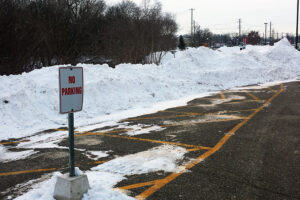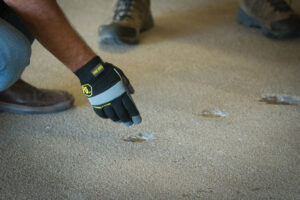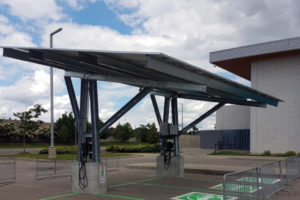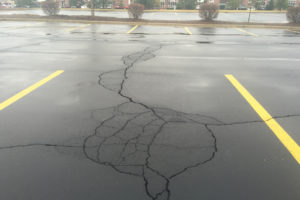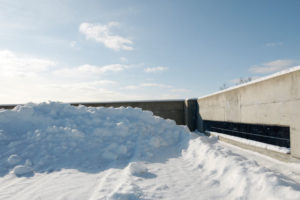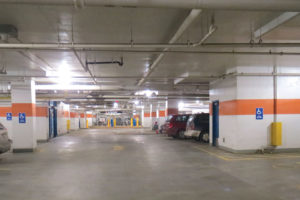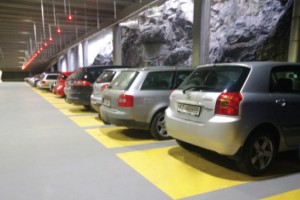By Pam Strong, Lake Simcoe Region Conservation Authority
In the Q2 2020 issue of Parker magazine, we highlighted the significant issues that salt is causing to our road and parking lot infrastructure, as well as to our freshwater resources. Many stakeholders, including road managers and environmental agencies, have been working to tackle this issue and apply less salt; however much of this effort has focused on roads. As part of this effort, the Lake Simcoe Region Conservation Authority retained GHD in 2017 to develop the Parking Lot Design Guidelines to Promote Road Salt Reduction. These guidelines were developed with the recognition that parking lots contribute a significant amount of chloride from salt, approximately 20% in the Lake Simcoe watershed, and significantly more in more urbanized areas, such as Toronto and Peel Region. These guidelines provide some tangible options for those involved in parking lot design and maintenance to reduce the amount of salt that is used in these areas, thus protecting parking lot infrastructure and water resources.
The guidelines were developed to demonstrate to those involved in the planning, design, and maintenance of parking lots that they can be designed from the outset in such a way that they require less salt to be applied to maintain an acceptable level of service and safety. Through stakeholder interviews and design charrettes, we identified four design features that can help to reduce the amount of salt needed to maintain safe conditions. Also included with the guidelines are site examples that demonstrate how the features can be used on several different development types. These site types include:
- Large size commercial development (greater than 10 ha)
- Medium size commercial development (5-6 ha)
- Small size commercial development (less than 3 ha)
- Institutional development (public school)
We also developed two…
By Bob Matich
Parking structures play an important role in society and are often the first touchpoint one has with a building so, ensuring customers have a favorable experience while interacting with a parking garage becomes important in protecting revenue generated by these assets. It follows that parking structures need to be effectively maintained. By the nature of where parking garages are located and how they are used, they are subjected to the effects of harsh environmental exposure, road chemicals and daily use. One of the most critical challenges facing parking structures today is moisture penetration. Unprotected structures suffer from water-induced damage, including deterioration and corrosion caused by alkalis, salts, and acids.
The key to preventative success against detriments outlined above is utilizing a system of products designed to work together. Liquid-applied high-performance traffic membranes are a major part of such systems as they offer long-lasting protection against the most damaging conditions. While these traffic coatings are exceptionally durable to traffic, there are circumstances which can exceed the limits of even the highest performance system. This article will outline an overview of situations that should be limited or avoided, as well as periodic maintenance procedures to follow. General topics include snow removal, high heat exposure, cleanup, repair for damaged areas, repair of high wear and recoating for aesthetic purposes.
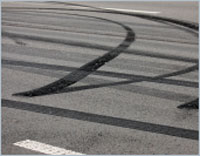
Prevention
Traffic membranes can tolerate a limited amount of extreme heat exposure. Exceeding these heat tolerances may damage or decrease the life of the system. High heat exposure may be caused by a variety of occurrences on a parking structure, including friction caused by spinning tires, non-extinguished cigarettes, or aggressive cleaning equipment. To limit exposure to high heat, it is recommended that signage be posted to limit speed, reminders to…
By Jay Boychuk and Lisa Oelke, hb Solar Canada
Parking lots are assets for those that charge for the spaces within them, or need them to attract customers or even employees. They serve one main purpose, to provide a place to leave cars, whether it is for an hour, or a day. What if that asset could be turned into a multi-purpose piece of land that not only provides parking, but generates additional cashflow, and helps the environment? Parking lots can do a surprising thing, they can generate electricity, and not only that, its green energy. Introducing solar covered parking can do just that.
Why would a parking lot operator want to be a producer of green energy? Large cities can have a tremendous amount of asphalt covered surfaces, some above 40% of their land mass. Suburban areas don’t escape these large amounts of asphalt coverage either. A lot of that density is roadways, with surface parking lots significantly adding to the total as well. What does all this asphalt do to our environment if we just use it for parking cars?
When it comes to identifying the greatest challenge to meeting Green House Gas (GHG) reductions, transportation leads in Ontario as the single-largest emitting sector in the economy at 35%. In response to these statistics, the Ontario Government is encouraging drivers to switch to electric vehicles, (EV’s) by offering rebates of up to $14,000 with the purchase of an EV. Quebec and B.C. have similar statistics and have also offered incentives. The Electric Vehicle Chargers Ontario(EVCO) incentive serves to increase access to charging stations with funding to build a network of fast-charging EV stations in cities, along highways, at workplaces, apartments, condos, and public places across Ontario. These measures create demand for additional EV charging in locations where cars need
to park…
By Scott Sounart, PE
Parking lots play a vital role in the success of the buildings they serve, serving as a de-facto lobby and delivering the initial impression of the property. A run-down parking lot creates an unattractive and unwelcoming image that makes the entire complex seem less appealing and inviting. Perhaps more importantly, a derelict lot can also pose potentially hazardous conditions for visitors and employees and their vehicles. Not only can this undermine a business by making it’s location less attractive to potential customers, but it can also lead to costly legal liability if visitors or employees suffer personal injury or damaged vehicles.
Yet, in spite of the obvious hazards that can be caused by run-down or improperly maintained parking lots, many owners treat their lots as an afterthought. This is partly a perception problem. Many owners develop lots rather than a parkade because they mistakenly think that parking lots are essentially maintenance-free. They assume that they can just pave over an area of land, paint in stripes for spaces, and forget about it.
While it’s true that the typical lot requires less maintenance than a parkade, maintenance is required. Sure, there are no concrete ramps, floors, or support columns to care for, but a parking lot’s pavement undergoes a great deal of wear and tear every day from multi-ton vehicles, rain and snow, and even the rays of the sun. As such, it’s essential to have an assessment and maintenance plan to preserve the property’s aesthetics, ensure customer and tenant safety, and extend the service life of the pavement.
Pavements can be one of a commercial facility’s most expensive assets to maintain, but these costs can be minimized. There are seven primary types of asphalt distress, any one of which can require repair. The good news is that a pavement…
In areas where winter weather affects the operation of a parking structure, removal of snow and ice is necessary, if not paramount, for functional performance, the public’s safety, and the long-term durability of the structure. Snow and ice removal can be difficult depending on the size, timing, and type of storm, and also the area to be maintained. For these reasons, knowing with what and how to remove snow and ice can greatly affect the operation of the structure. The basic parameters for snow and ice removal include planning, proper equipment, chemical deicers, written procedures, and how-to instruction for snow removal personnel.
Planning
When removing snow and ice, planning plays an important role for a successful operation. Basic planning and specifications for snow removal begins during the initial design phase of the parking structure. The owner, architect, engineer, contractor, and precast/prestress concrete manufacturer must all be involved in determining how snow and ice will be removed. Operations such as removal of snow and ice from the deck surface, storage of snow and ice, and the use of certain types of equipment can cause major functional and performance problems to the structure if not properly addressed during the initial design phase.
When an architect or engineer begins considering the location and layout of a parking structure, snow and ice removal operations should be based on local climate conditions. Anticipated maximum snow fall and frequency will influence planning strategies. Once parameters for snow and ice removal have been established, features for storage or removal must be designed into the structure. Removal of snow is typically handled by moving the snow to a snow chute or snow melting equipment, or by moving to and through a gate opening in exterior spandrels.
Storage of snow requires strict operating procedures and protected dumping zones to ensure the safety…
Integrating digital technologies into dynamic parking management
By Indigo
Introduction: THE NEW MOBILITY
As a symbol of freedom, mobility, and autonomy, the automobile has changed the shape of our cities and suburbs, yet in the past century, it has evolved beyond our expectations.
Cars now come equipped with advanced hardware that can avoid collisions, they can be self-driving, and yet the great paradox is that a typical car spends most of its time immobile. A car is parked on average 95% of the time, when it is not stuck in a traffic jam.
The digital revolution, a major upheaval caused by technological advances, primarily computers and the Internet, has placed us in an era of accelerating change.
In industrialized countries, this change has shaken several sectors of the economy. While cars become sophisticated enough to be self-driving, and as automakers become mobility providers, cities become smarter by using and integrating new technologies to meet the challenges of the modern city: transportation, governance, and citizen services, to name a few.
Traffic congestion ranks high on the list of evils that afflict urban areas. It increases greenhouse gas emissions and is largely responsible for the smog in big cities. The search for available parking is, in part, largely responsible for congestion – 90% of city motorists lose up to 20 minutes a day looking for a parking space, by slowly circulating, or by immobilizing traffic to parallel park.
With the emergence of “smart” parking, solutions such as nested technologies in the roadway and parking areas, and connections to new mobile tools are being put in place.
The technological solutions to make parking more fluid, by eliminating traffic obstacles, and customizing and facilitating the driver’s experience exist.
But the growing digital revolution has seen the emergence of a large number of contenders for the next “unicorn”, technological start-ups that disrupt sectors of the…
By David Poole
In a program involving 13 hospital parkades in Calgary and Red Deer, Alberta Health Services (AHS) upgraded old HID lighting to LED technology, creating an annual cost savings of almost $250,000, while bringing light levels to current standards, and improving the overall quality of illumination.
Illumination in many covered or underground hospital parking lots in Alberta is provided by a mixture of HID (High Intensity Discharge – typically metal halide or high pressure sodium) and fluorescent T8 lighting. Lighting levels varied greatly, from very dim in some cases, to illuminated well beyond current standards for parkade lighting in others. In a retrofit and redesign program, funded by AHS Parking Services department, thirteen parkades were selected for a change-over to LED lighting technology. It should be noted that AHS Parking Services is an ancillary operation and is committed to providing an operation that is sustainable, effective and efficient. With this in mind, the project included a redesign of the lighting, and the use of motion and ambient daylight sensors in order to provide adequate light at all times and further reduce energy consumption and costs.
Project Details
Alberta Health Services engaged a lighting consultant to provide tender documents for the upgraded lighting system and provide pre and post electrical measurements in order to verify the savings. The consultant utilized the current Illuminating Engineering Society of North America (IESNA) recommendations to redesign the parkade lighting. The lighting consultant and AHS worked together to evaluate a number of LED lighting products in order to provide an acceptable number of approved products based on a number of factors including performance, quality, warranty, history, etc.
A total of 4895 fixtures were affected by this project. The simplest upgrade consisted of replacing existing fluorescent T8 tubes with LED tubes of equal length but reduced wattage, using the…
By Ellise Gasner
Times are positively evolving and the focus on sustainability is being embraced by various industries worldwide.
The Parking industry is fortunate that sustainable parking surface alternatives are readily available, easy to incorporate and affordable. Permeable parking has been the norm for our European neighbours for well over two decades and is now becoming widely incorporated throughout North America. (more…)
By Ben Smith, B.E.Env
Multi-story parking lots are unique buildings, one in which all elements of the structure are normally exposed to the public. These structures face unique challenges as well as exposure to niche stresses as well as physical and chemical abuse.
Although often underestimated, the correct specification of waterproofing and surfacing materials is critical, within parking environments, to delivering a long-term, structurally protected and safe facility for parking operators and vehicle owners.
The most suitable deck coating material will largely depend on where within the multi-level or underground parking facility they are to be installed as well as the conditions to which the material will be subjected.
This can range from slip-resistance, durability and service life requirements through to temperature cycling, UV exposure and any problematic existing substrate conditions as well as any anticipated movement within the structure.
Parking has become a vital part of today’s mobile world with more vehicles on the road than ever before. As a result, the demand for parking is at an all-time high with vehicle owners searching for secure and safe environments to house their vehicles when they are without them.
The parking lot is often the first point of call for a visitor to any public, private or commercial venue. It is the “front door” of the building, while at the same time serving its primary functional role. There is no doubt that initial appearance, ease of use, signage, bright lighting and clear directional marking all help to make a parking development a more positive and safer environment.
As new build multi-story and underground parking structures are more frequently adorning the urban landscape so too are older structures being renovated to meet both modern design and safety requirements.
One critical design consideration is the deck coating material chosen to protect the reinforced concrete structure, in order to protect…
By Lyndon McLean
Winter salt is an inexpensive and easy way to deal with icy patches. Trucks salting roadways and neighbours spreading a little de-icer on the front sidewalk are familiar sight. But as a tragedy such as the collapse of the Algo Centre Mall in Elliot Lake shows, there can be high costs associated with overuse of salt and a lack of facility maintenance.
The Smart About Salt Council is an independent, not-for-profit organization dedicated to protecting the environment through programs that improve management of winter salt used to control ice on sidewalks, parking lots and roadways. The council was started by its partners, the Region of Waterloo, Landscape Ontario Horticultural Trades Association, Building Owners and Managers Association of Ottawa, and Ontario Good Roads Association.
In response to concerns over rising levels of sodium and chlorides in municipal drinking water, the Region of Waterloo took action. One of the first large municipalities to recognize that winter salt use is a major problem, they developed an active strategy for more efficient salt use on its roads. But they also developed the Smart About Salt program, designed to teach private contractors and property managers the best practices of salt management that help to reduce its use while still ensuring that public safety is not compromised.
From building owners to snow removal contractors to the general public, each partner has an important stake in ensuring that its members and constituents understand the program’s value in protecting the environment. All partners encourage everyone to participate in and promote this program. For example, the Region of Waterloo now requires all of its contractors that apply salt on its building properties to be registered in the Smart About Salt program, as contracts are renewed.

Smart About Salt’s Guiding Principles
Mission:
- To protect freshwater…


